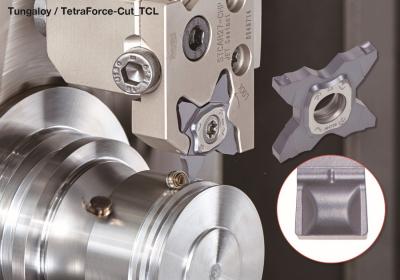
Tungaloy expands its TetraForce-Cut, a four-edged indexable grooving tool series, to include the new TCL27-style chipbreaker.
TetraForce-Cut’s indexable insert boasts cost-effective, four cutting edges with a grooving depth of up to 6.4mm. The toolholder has a unique insert clamping structure that ensures high repeatability and accuracy for maximum insert stability and tool life.
The new TCL27-style chipbreaker features a deep dimple profile on the rake face, providing low cutting force and effective chip control during difficult grooving operations. The geometry is available in a universal AH725 grade, which improves machining efficiency and stability.
Combined with existing TCS27- and TCM27-style chipbreakers, the comprehensive offering of TetraForce-Cut grooving inserts will meet a wide range of grooving needs in general lathes and Swiss-type machines.
At a Glance
New TCL27-style chipbreaker provides stable chip control and low cutting force
A deep dimple profile of the rake face ensures chip ejection in deep grooves, eliminating chip entanglement on the workpiece
Ideal for carbon steel, alloy steel, stainless steel, as well as heat-resistant alloy
Contact Details
Related Glossary Terms
- chipbreaker
chipbreaker
Groove or other tool geometry that breaks chips into small fragments as they come off the workpiece. Designed to prevent chips from becoming so long that they are difficult to control, catch in turning parts and cause safety problems.
- cutting force
cutting force
Engagement of a tool’s cutting edge with a workpiece generates a cutting force. Such a cutting force combines tangential, feed and radial forces, which can be measured by a dynamometer. Of the three cutting force components, tangential force is the greatest. Tangential force generates torque and accounts for more than 95 percent of the machining power. See dynamometer.
- grooving
grooving
Machining grooves and shallow channels. Example: grooving ball-bearing raceways. Typically performed by tools that are capable of light cuts at high feed rates. Imparts high-quality finish.
- indexable insert
indexable insert
Replaceable tool that clamps into a tool body, drill, mill or other cutter body designed to accommodate inserts. Most inserts are made of cemented carbide. Often they are coated with a hard material. Other insert materials are ceramic, cermet, polycrystalline cubic boron nitride and polycrystalline diamond. The insert is used until dull, then indexed, or turned, to expose a fresh cutting edge. When the entire insert is dull, it is usually discarded. Some inserts can be resharpened.
- rake
rake
Angle of inclination between the face of the cutting tool and the workpiece. If the face of the tool lies in a plane through the axis of the workpiece, the tool is said to have a neutral, or zero, rake. If the inclination of the tool face makes the cutting edge more acute than when the rake angle is zero, the rake is positive. If the inclination of the tool face makes the cutting edge less acute or more blunt than when the rake angle is zero, the rake is negative.
- toolholder
toolholder
Secures a cutting tool during a machining operation. Basic types include block, cartridge, chuck, collet, fixed, modular, quick-change and rotating.

